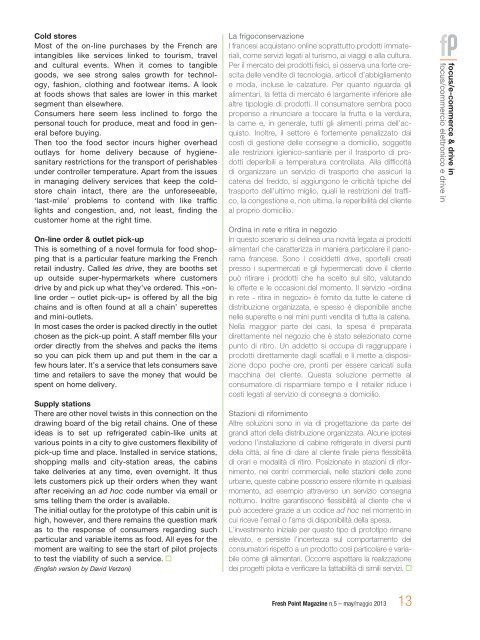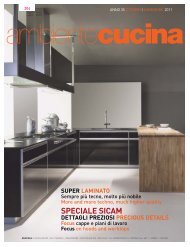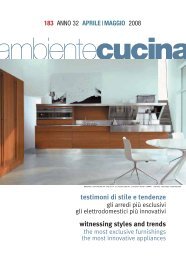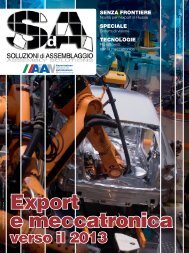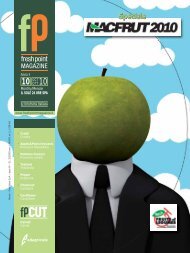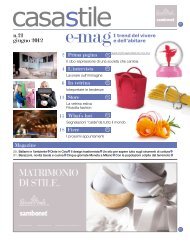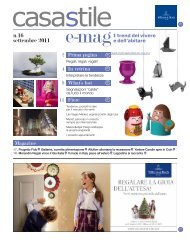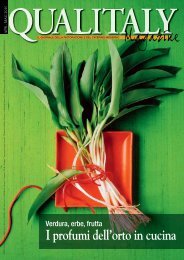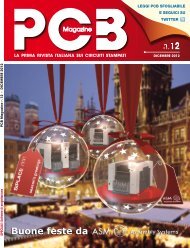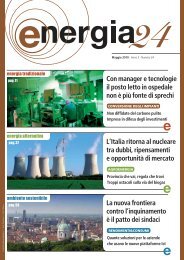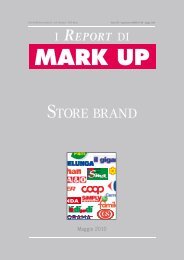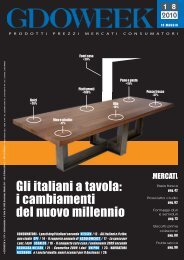Fresh Point Magazine - B2B24 - Il Sole 24 Ore
Fresh Point Magazine - B2B24 - Il Sole 24 Ore
Fresh Point Magazine - B2B24 - Il Sole 24 Ore
Create successful ePaper yourself
Turn your PDF publications into a flip-book with our unique Google optimized e-Paper software.
Cold stores<br />
Most of the on-line purchases by the French are<br />
intangibles like services linked to tourism, travel<br />
and cultural events. When it comes to tangible<br />
goods, we see strong sales growth for technology,<br />
fashion, clothing and footwear items. A look<br />
at foods shows that sales are lower in this market<br />
segment than elsewhere.<br />
Consumers here seem less inclined to forgo the<br />
personal touch for produce, meat and food in general<br />
before buying.<br />
Then too the food sector incurs higher overhead<br />
outlays for home delivery because of hygienesanitary<br />
restrictions for the transport of perishables<br />
under controller temperature. Apart from the issues<br />
in managing delivery services that keep the coldstore<br />
chain intact, there are the unforeseeable,<br />
‘last-mile’ problems to contend with like traffi c<br />
lights and congestion, and, not least, fi nding the<br />
customer home at the right time.<br />
On-line order & outlet pick-up<br />
This is something of a novel formula for food shopping<br />
that is a particular feature marking the French<br />
retail industry. Called les drive, they are booths set<br />
up outside super-hypermarkets where customers<br />
drive by and pick up what they’ve ordered. This «online<br />
order – outlet pick-up» is offered by all the big<br />
chains and is often found at all a chain’ superettes<br />
and mini-outlets.<br />
In most cases the order is packed directly in the outlet<br />
chosen as the pick-up point. A staff member fi lls your<br />
order directly from the shelves and packs the items<br />
so you can pick them up and put them in the car a<br />
few hours later. It’s a service that lets consumers save<br />
time and retailers to save the money that would be<br />
spent on home delivery.<br />
Supply stations<br />
There are other novel twists in this connection on the<br />
drawing board of the big retail chains. One of these<br />
ideas is to set up refrigerated cabin-like units at<br />
various points in a city to give customers fl exibility of<br />
pick-up time and place. Installed in service stations,<br />
shopping malls and city-station areas, the cabins<br />
take deliveries at any time, even overnight. It thus<br />
lets customers pick up their orders when they want<br />
after receiving an ad hoc code number via email or<br />
sms telling them the order is available.<br />
The initial outlay for the prototype of this cabin unit is<br />
high, however, and there remains the question mark<br />
as to the response of consumers regarding such<br />
particular and variable items as food. All eyes for the<br />
moment are waiting to see the start of pilot projects<br />
to test the viability of such a service.<br />
(English version by David Verzoni)<br />
La frigoconservazione<br />
I francesi acquistano online soprattutto prodotti immateriali<br />
come servizi legati al turismo ai viaggi e alla cultura.<br />
Per il mercato dei prodotti fi sici, si osserva una forte crescita<br />
delle vendite di tecnologia, articoli d’abbigliamento<br />
e moda, incluse le calzature. Per quanto riguarda gli<br />
alimentari, la fetta di mercato é largamente inferiore alle<br />
altre tipologie di prodotti. <strong>Il</strong> consumatore sembra poco<br />
propenso a rinunciare a toccare la frutta e la verdura,<br />
la carne e in generale tutti gli alimenti prima dell’acquisto.<br />
Inoltre il settore é fortemente penalizzato dai<br />
costi di gestione delle consegne a domicilio, soggette<br />
alle restrizioni igienico-santiarie per il trasporto di prodotti<br />
deperibili a temperatura controllata. Alla diffi coltà<br />
di organizzare un servizio di trasporto che assicuri la<br />
catena del freddo, si aggiungono le criticità tipiche del<br />
trasporto dell’ultimo miglio, quali le restrizioni del traffi -<br />
co, la congestione e, non ultima, la reperibilità del cliente<br />
al proprio domicilio.<br />
Ordina in rete e ritira in negozio<br />
In questo scenario si delinea una novità legata ai prodotti<br />
alimentari che caratterizza in maniera particolare il panorama<br />
francese. Sono i cosiddetti drive, sportelli creati<br />
presso i supermercati e gli hypermercati dove il cliente<br />
può ritirare i prodotti che ha scelto sul sito, valutando<br />
le offerte e le occasioni del momento. <strong>Il</strong> servizio «ordina<br />
in rete ritira in negozio» è fornito da tutte le catene di<br />
distribuzione organizzata, e spesso é disponibile anche<br />
nelle superette e nei mini punti vendita di tutta la catena.<br />
Nella maggior parte dei casi, la spesa é preparata<br />
direttamente nel negozio che è stato selezionato come<br />
punto di ritiro. Un addetto si occupa di raggruppare i<br />
prodotti direttamente dagli scaffali e li mette a disposizione<br />
dopo poche ore, pronti per essere caricati sulla<br />
macchina del cliente. Questa soluzione permette al<br />
consumatore di risparmiare tempo e il retailer riduce i<br />
costi legati al servizio di consegna a domicilio.<br />
Stazioni di rifornimento<br />
Altre soluzioni sono in via di progettazione da parte dei<br />
grandi attori della distribuzione organizzata. Alcune ipotesi<br />
vedono l’installazione di cabine refrigerate in diversi punti<br />
della città al fi ne di dare al cliente fi nale piena fl essibilità<br />
di orari e modalità di ritiro. Posizionate in stazioni di rifornimento,<br />
nei centri commerciali, nelle stazioni delle zone<br />
urbane queste cabine possono essere rifornite in qualsiasi<br />
momento ad esempio attraverso un servizio consegna<br />
notturno. Inoltre garantiscono fl essibilità al cliente che vi<br />
può accedere grazie a un codice ad hoc nel momento in<br />
cui riceve l’email o l’sms di disponibilità della spesa.<br />
L’investimento iniziale per questo tipo di prototipo rimane<br />
elevato, e persiste l’incertezza sul comportamento dei<br />
consumatori rispetto a un prodotto così particolare e variabile<br />
come gli alimentari. Occorre aspettare la realizzazione<br />
dei progetti pilota e verifi care la fattabilità di simili servizi.<br />
<strong>Fresh</strong> <strong>Point</strong> <strong>Magazine</strong> n.5 – may/maggio 2013<br />
13<br />
focus/e-commerce & drive in<br />
focus/commercio elettronico e drive in


